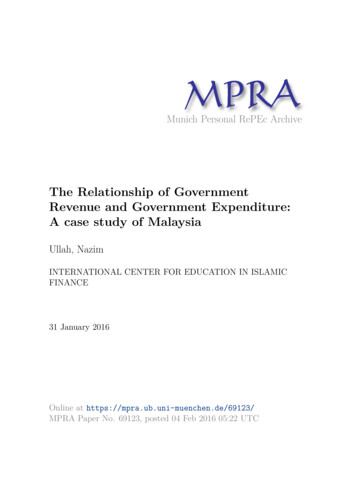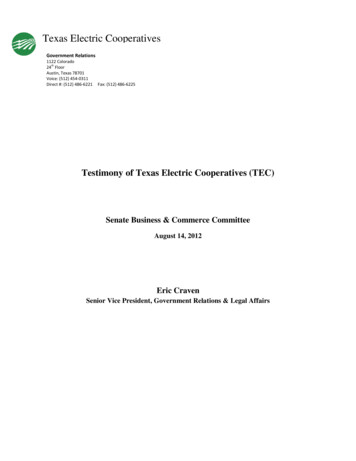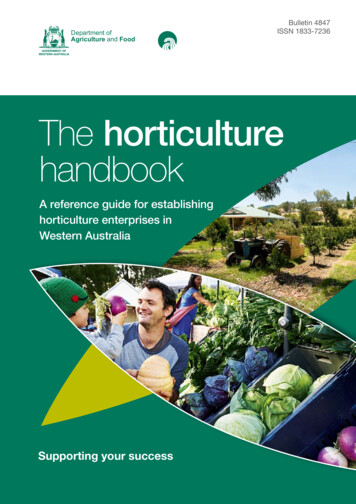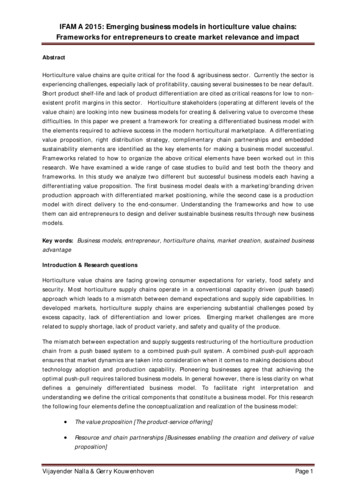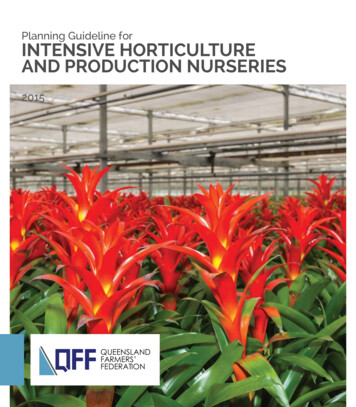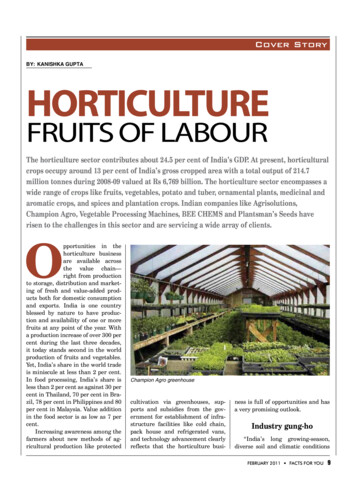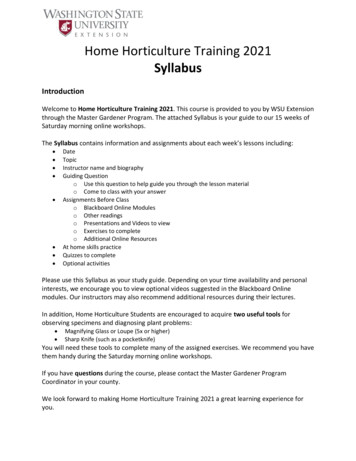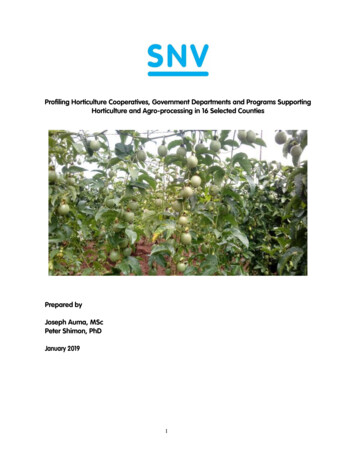
Transcription
Profiling Horticulture Cooperatives, Government Departments and Programs SupportingHorticulture and Agro-processing in 16 Selected CountiesPrepared byJoseph Auma, MScPeter Shimon, PhDJanuary 20191
AcknowledgementThis study would not have been achieved without funding from Netherlands government through its Embassyin Kenya. We acknowledge the role of SNV Netherlands Development Organizations and its partners Solidaridad, HIVOS and Delphy in its efforts to develop farmers in Kenya and specifically in the sixteen countieswhere HortIMPACT programme has been implemented since 2015. Specifically, we acknowledge the role ofBernard Ndolo, HortIMPACT programme Advisor and his team for his good coordination and provision oftransport and other logistics especially enumerators training in Nakuru and Nairobi, scoping field visits and fortrusting our delivery capacity in this assignment.Similarly, we acknowledge all our contact persons and key Informants in the sixteen counties mainly CountyDirectors of Agriculture and their extension teams; county crops and horticultural crops officers, Countycommissioner of cooperatives and staff, County Coordinating units of the Swedish funded developmentprogramme-ASDSP, County coordinating unit of the World Bank Funded Programmes-NARIG and KCSAP andmany other stakeholders, partners and collaborators in horticulture for finding time to provide usefulinformation used in writing this report. We also acknowledge the many enumerators and supervisors who hadto crisscross vast counties in very short time engaging horticultural farmers, group and cooperative officialsfor interview.Finally, our greatest gratitude goes to the smallholder horticultural farmers in 64 organizations in the 16counties who had to be mobilized at short notice, sat long hours providing information compiled in this report.Your efforts are not taken for granted.2
Table of ContentsACRONYMS . 4EXECUTIVE SUMMARY . 51.INTRODUCTION . 81.1.Overview of Kenya Market-Led Horticulture Program . 81.2.Background of the project area . 81.3.Rationale for Profiling Farmer organizations . 81.4.Scope of the Assessment . 92.TECHNICAL APPROACH AND METHODOLOGY . 92.1Scoping. 92.2Capacity Measurement Tool . 92.3The revised capacity and performance assessment tool . 102.4Data Collection . 102.5Data analysis . 113.ASSESSMENT FINDINGS AND DISCUSSIONS . 113.1 Bomet County . 123.2Bungoma County . 143.3Nandi County . 153.4Narok County. 173.5Kajiado County . 183.6Kiambu County . 193.7Kitui County . 213.8Laikipia County . 223.9Machakos County . 253.10Makueni County . 263.11Meru County . 263.12Nakuru County . 283.13Nyandarua County . 293.14Nyeri County . 313.15Transzoia County. 333.16Uasin Gishu County . 343.17Summary of the SBOs assessment results across the counties . 384.CONCLUSION AND RECOMMENDATIONS . 394.1Conclusion . 394.2Recommendations . 405.0 APPENDICES . 43Appendix 1: List of cooperatives identified during scoping phase of the study . 43SUMMARY FOR ANALYSIS OF CAPACITIES ACROSS THE COUNTY . 45Appendix 2: Assessed SBOs Profiles by County . 462.1Bomet County cooperatives assessment reports . 462.2BUNGOMA County cooperatives assessment reports . 532.3NANDI County Assessment Reports . 582.4NAROK County Reports . 622.5KIAMBU County Reports . 702.6Kajiado County Assessment Reports by CBO . 752.7Kitui County Assessment Reports by SBO . 792.8Laikipia County Assessment Reports by SBO . 832.9Machakos County Assessment Reports by SBO . 872.10Makueni County Assessment Reports . 912.11Meru County Assessment Reports . 952.12Nakuru County Assessment Reports by SBO. 992.13Nyandarua County Assessment Reports by SBO. 1032.14Transzoia County Assessment Reports by SBO . 1052.15Uasin Gishu County Assessment Reports by SBO . 1103
ALAgriculture Sector Development Support ProgrammeThe Kenya Market-led Horticulture ProgramNetherlands Development OrganizationSmall Business OrganizationsGeneric organizational capacity assessment toolKenya climate Smart Agricultural Project-World bank FundedNational Agricultural and Rural Inclusive Growth-World bank funded projectAfrica Development BankCommunity-based OrganizationsProducers organizationsNational Irrigation BoardThe Norwegian Agency for Development CooperationConstituency development FundFood and Agriculture Organization of the United NationsInternational Fund for Agricultural DevelopmentUnited States Agency for International DevelopmentAccelerated Value Chain DevelopmentInternational Potato CentreKenya Plant Health Inspectorate CervicesHorticultural Crops DirectorateKenya Cereals Enhancement Programme - Climate Resilience Agricultural Livelihood(window)4
EXECUTIVE SUMMARYIntroductionThe Kenya Market-led Horticulture Program (HortIMPACT) is a 5-year project (2015-2019), funded by theNetherlands government through its Embassy in Kenya and implemented by SNV Netherlands DevelopmentOrganization and consortium partners Solidaridad, HIVOS and Delphy. The program is contributing toincreased food security, increased incomes and a dynamic and sustainable horticulture sector in Kenya, witha strong focus on private sector development. The HortIMPACT programme funded this study to profilecooperatives and farmers groups in horticultural value chains and to understand key stakeholders, their coreactivities and level of development to inform the right mix for partnership in scaling interventions (businesscases) in 16 counties in Kenya; Kiambu, Kajiado, Nyeri, Meru, Nyandarua, Laikipia, Nakuru, Narok, Bomet,Uasin Gishu, Nandi, Bungoma, Transnzoia, Kitui, Makueni, and Machakos counties. The specific objectivesaddressed by the study were to;i.Understand farmer organizations (groups or cooperatives) specializing in horticulture in the selectedcounties.ii.Understand women’s and youth groups and SME associations related to agri-business activitiesiii.Understand government programs and departments that offer support services (technical andfinancial) to the horticulture industry at the national level and in the selected counties.MethodologyThe study employed a two-phased approach to data and information collection; 1) County scoping study and2) individual organization assessment using a standardized and customized Small Business Organizations(SBO) assessment tool. Scoping study conducted by the consultants preliminarily identified horticulturalorganizations assessed in the second phase and also collected primary information on horticulture fromstakeholders, their roles in the value chains and horticultural related infrastructure development in eachcounty. Key sources of information in the scoping phase was mainly County department of Cooperatives,Agriculture and related National and County donor funded projects and programmes.The individual organizations assessment phase was conducted after recruitment and training of enumeratorsand county supervisors for each county. The training on the administration of the assessment tool wasconducted in Nakuru and Nairobi for one day to equip the trainees with the skills to administer the tool toorganization officials and a few members in pairs at the same time and the supervisor to summarize collectedinformation into a brief report for consolidation by the consultants.The modified version of the generic organizational capacity assessment tool (OCAT) that has been developedand refined based on existing knowledge of organization development and experience of non-governmentalorganizations and community-based organizations was used. The OCAT was designed to identify anorganization’s relative strengths and weaknesses and generate baseline information needed to developstrengtheninginterventions. The standard OCAT identifies and examines seven elements of organizationeffectiveness as governance, management capacity, human resources, financialdelivery, externalrelationsand sustainability in order to provide evidence to strengthen organizational,managerial, and financial or resource sustainability.developmentresources, serviceThe framework recognizes that organizationis a long-term, interactive, and iterative process that include several distinct stages throughwhich an organization passes, and which could be summarized in to four growth stages; 1) the start-up ornascent stage, 2) Development or emerging stage, 3) Expanding, growth, or consolidation stage and 4)Sustainability or mature.5
Study ResultsThe study assessed 64 relevant farmers organizations (groups and cooperatives), at least four in each countyand the results (average score rating ranges between 0.02 and 0.76) shows that all the organization are instage one of growth; start-up or nascent stage. This implies that, farmer groups assessed are below averagein capacity and performance (0.19); meaning, most of the SBOs are just beginning to develop structuresrequired for effective performance in the key capacity areas. Supply, processing and marketing recorded thehighest score (0.22), although below-the-edge performance in terms of development stages. This was followedclosely by operational capacities (0.20). The lowest capacity scores were recorded in leadership (0.13) andadaptive
Profiling Horticulture Cooperatives, Government Departments and Programs Supporting Horticulture and Agro-processing in 16 Selected Counties Prepared by Joseph Auma, MSc Peter Shimon, PhD January 2019 . 2 Acknowledgement This study would not have been achieved without funding from Netherlands government through its Embassy in Kenya. We acknowledge the role of SNV Netherlands
